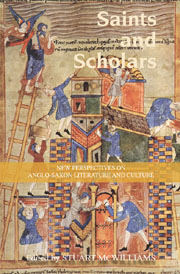 Saints and Scholars
Saints and Scholars Book contents
- Frontmatter
- Contents
- List of Contributors
- Abbreviations
- Introduction
- I Hagiography and the Homiletic Tradition
- II Aspects of Community and Consumption
- 8 Stories from the Court of King Alfred
- 9 De Duodecim Abusiuis, Lordship and Kingship in Anglo-Saxon England
- 10 Reluctant Appetites: Anglo-Saxon Attitudes towards Fasting
- 11 A Note on the Function of the Inscribed Strip from the Staffordshire Hoard
- 12 The Shining of the Sun in the Twelve Nights of Christmas
- 13 Sin and Laughter in Late Anglo-Saxon England: The Case of Old English (h)leahtor
- 14 Marginal Activity? Post-Conquest Old English Readers and their Notes
- III Reflections on Old English Scholarship
- Poems
- Hugh Magennis: A Bibliography, 1981–2011
- Index
- Tabula Gratulatoria
11 - A Note on the Function of the Inscribed Strip from the Staffordshire Hoard
from II - Aspects of Community and Consumption
Published online by Cambridge University Press: 05 February 2013
- Frontmatter
- Contents
- List of Contributors
- Abbreviations
- Introduction
- I Hagiography and the Homiletic Tradition
- II Aspects of Community and Consumption
- 8 Stories from the Court of King Alfred
- 9 De Duodecim Abusiuis, Lordship and Kingship in Anglo-Saxon England
- 10 Reluctant Appetites: Anglo-Saxon Attitudes towards Fasting
- 11 A Note on the Function of the Inscribed Strip from the Staffordshire Hoard
- 12 The Shining of the Sun in the Twelve Nights of Christmas
- 13 Sin and Laughter in Late Anglo-Saxon England: The Case of Old English (h)leahtor
- 14 Marginal Activity? Post-Conquest Old English Readers and their Notes
- III Reflections on Old English Scholarship
- Poems
- Hugh Magennis: A Bibliography, 1981–2011
- Index
- Tabula Gratulatoria
Summary
This short paper is offered to Hugh as a mark of great respect for his work as an Anglo-Saxon scholar over many years. Hugh's interests have covered many aspects of the literature and culture of Anglo-Saxon England and I have no doubt that all those working on the Staffordshire hoard of Anglo-Saxon gold and silver will greatly benefit from his interest in it. As is now well known, amongst the many highly decorated gold and silver objects found in 2009 in the hoard, there is only one that is inscribed. This is a thin strip of gold that contains a biblical text. This strip is interesting for many reasons, not least the fact that it is not clear exactly what its function was, although the attached pin and the holes indicate that it was originally fastened onto some other object. In this paper the Staffordshire strip is compared with other known Anglo-Saxon inscribed strips in an attempt both to pick out similarities and differences and to discuss the functions of such strips.
The word ‘strip’, or ‘decorative strip’, is sometimes used rather loosely by Anglo-Saxonists who have written about such objects, including by the present author. The term is quite vague, and is thus rather useful for describing an object whose function is less than clear. In this, it can be compared with another, equally vague and equally useful, term of description, ‘strap-end’.
- Type
- Chapter
- Information
- Saints and ScholarsNew Perspectives on Anglo-Saxon Literature and Culture in Honour of Hugh Magennis, pp. 187 - 194Publisher: Boydell & BrewerPrint publication year: 2012


